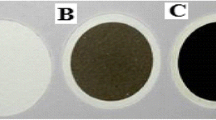Abstract
Samples of PM2.5 were collected to measure the concentrations of its chemical constituents at two rural locations, Potsdam and Stockton, NY from November 2002 to August 2005. These samples were collected on multiple filters at both sites, every third day for a 24-h interval with a speciation network sampler. The Teflo® filters were analyzed for PM2.5 mass by gravimetry, and elemental composition by X-ray fluorescence (XRF). Nylasorb® filters and Teflo® filters were leached with water and analyzed for anions and cations, respectively, by ion chromatography (IC). Fine particulate matter (PM2.5) mass and its inorganic component measurements were statistically characterized, and the temporal behavior of these species were assessed. Over the entire study period, PM2.5 mass concentrations were lower at Potsdam (8.35 μg/m3) than at Stockton (10.24 μg/m3). At both locations, organic matter (OM) was the highest contributor to mass. Sulfate was the second highest contributor to mass at 27.0% at Potsdam, and 28.7% at Stockton. Nitrate contributions to mass of 8.9 and 9.5% at Potsdam and Stockton, respectively, were the third highest. At both locations, fine PM mass exhibited an annual cycle with a pronounced summer peak and indications of another peak during the winter, consistent with an overall increase in the rate of secondary aerosol formation during the summer, and increased partitioning of ammonium nitrate to the particle phase and condensation of other semi-volatiles during the winter, respectively. An ion-balance analysis indicated that at both locations, during the summers as well as in the winters, the aerosol was acidic. Lognormal frequency distribution fits to the measured mass concentrations on a seasonal basis indicated the overall increase in particle phase secondary aerosol (sulfate and SOA) concentrations during the summers compared to the winters at both locations.
Similar content being viewed by others
References
Draxler, R. R., & Rolph, G. D. (2003). HYSPLIT (Hybrid Single-Particle Lagrangian Integrated Trajectory) Model. NOAA Air Resources Laboratory, Silver Spring, MD. Access via NOAA ARL READY Website http://www.arl.noaa.gov/ready/hysplit4.html.
deNevers, N., Lee, K. W., & Frank, N. H. (1979). Patterns in TSP distribution. Journal of the Air Pollution Control Association, 29, 32–35.
Hopke, P. K., Liu, W., Han, Y. J., Yi, S. M., Holsen, T. M., Scott, C., & Milligan, M. (2003). Measured summertime concentrations of particulate components, Hg0, and speciated polycyclic aromatic hydrocarbons at rural sites in New York State. Environmental Pollution, 123, 413–425.
Kao, A. S., & Friedlander, S. K. (1994). Chemical signatures of the Los Angeles aerosol (dp < 3.5 mm). Aerosol Science and Technology, 21, 283–293.
Kao, A. S., & Friedlander, S. K. (1995). Frequency distributions of PM10 chemical components and their sources. Environmental Science & Technology, 29, 19–28.
Karaca, F., Alagha, O., & Erturk, F. (2005). Statistical characterization of atmospheric PM10 and PM2.5 concentrations at a non-impacted suburban site of Istanbul, Turkey. Chemosphere, 59, 1183–1190.
Liu, W., Hopke, P. K., Han, Y.-J., Yi, S.-M., Holsen, T. M., & Cybart, S., et al. (2003b). Application of receptor modeling to atmospheric constituents at Potsdam and Stockton, NY. Atmospheric Environment, 37, 4997–5007.
Liu, W., Hopke, P. K., & VanCuren, R. A. (2003a). Origins of fine aerosol mass in the western United States using positive matrix factorization. Journal of Geophysical Research, 108(D23), 4716.
Lu, H.-C. (2002). The statistical characters of PM10 concentration in Taiwan area. Atmospheric Environment, 36, 491–502.
McMurry, P. H. (2000). A review of atmospheric aerosol measurements. Atmospheric Environment, 34, 1959–1999.
Natural Resources Canada, Canadian Forest Services (accessed on 07/28/2006) http://www.nrcan.gc.ca/cfs-scf/science/prodserv/firereport/archives_e.php
Ott, W. (1990). A physical explanation of the log normality of pollutant concentrations. Journal of Air & Waste Management Association, 40, 1378–1383.
Paatero, P., & Hopke, P. K. (2003). Discarding and downweighting high noise variable in factor analysis models. Analytica Chimica Acta, 490, 277–289.
Research Triangle Institute (2003a). Standard operating procedure for PM2.5 anion analysis, environmental & industrial sciences division, research triangle institute, Research triangle Park, NC’ (accessed on 04/23/2006). http://www.epa.gov/ttn/amtic/files/ambient/pm25/spec/anionsop.pdf.
Research Triangle Institute (2003b). Standard operating procedure for PM2.5 cation analysis, environmental & industrial sciences division, research triangle institute, Research triangle Park, NC’ (accessed on 04/23/2006). http://www.epa.gov/ttn/amtic/files/ambient/pm25/spec/cationsop.pdf.
Schwab, J. J., Felton, H. D., & Demerjian, K. L. (2004). Aerosol chemical composition in New York State from integrated filter samples: Urban/rural and seasonal contrasts. Journal of Geophysical Research, 109, D16S05.
Seinfeld, J. H., & Pandis, S. N. (1998). Atmospheric chemistry and physics. New York: Wiley.
Sunder Raman, R. (2006). Investigation of the nature and behavior of carbonaceous species and source apportionment of ambient particulate matter. Dissertation submitted to the Department of Chemical and Biomolecular Engineering, Clarkson University, Potsdam, NY.
Sunder Raman, R., & Hopke, P. K. (2006). An ion chromatographic analysis of water-soluble, short-chain organic acids in ambient particulate matter. International Journal of Environmental Analytical Chemistry, 86(10, 20), 767–777 (Note: First author last name misspelt in the journal as Sundar Raman).
Sunder Raman, R., & Hopke, P. K. (2007). Carbonaceous aerosol at two rural locations in New York State: Characterization and behavior. Journal of Geophysical Research (in press).
Author information
Authors and Affiliations
Corresponding author
Electronic supplementary material
Below is the link to the Electronic supplementary material
Rights and permissions
About this article
Cite this article
Sunder Raman, R., Hopke, P.K. & Holsen, T.M. Characterization of fine aerosol and its inorganic components at two rural locations in New York State. Environ Monit Assess 144, 351–366 (2008). https://doi.org/10.1007/s10661-007-9998-2
Received:
Accepted:
Published:
Issue Date:
DOI: https://doi.org/10.1007/s10661-007-9998-2




